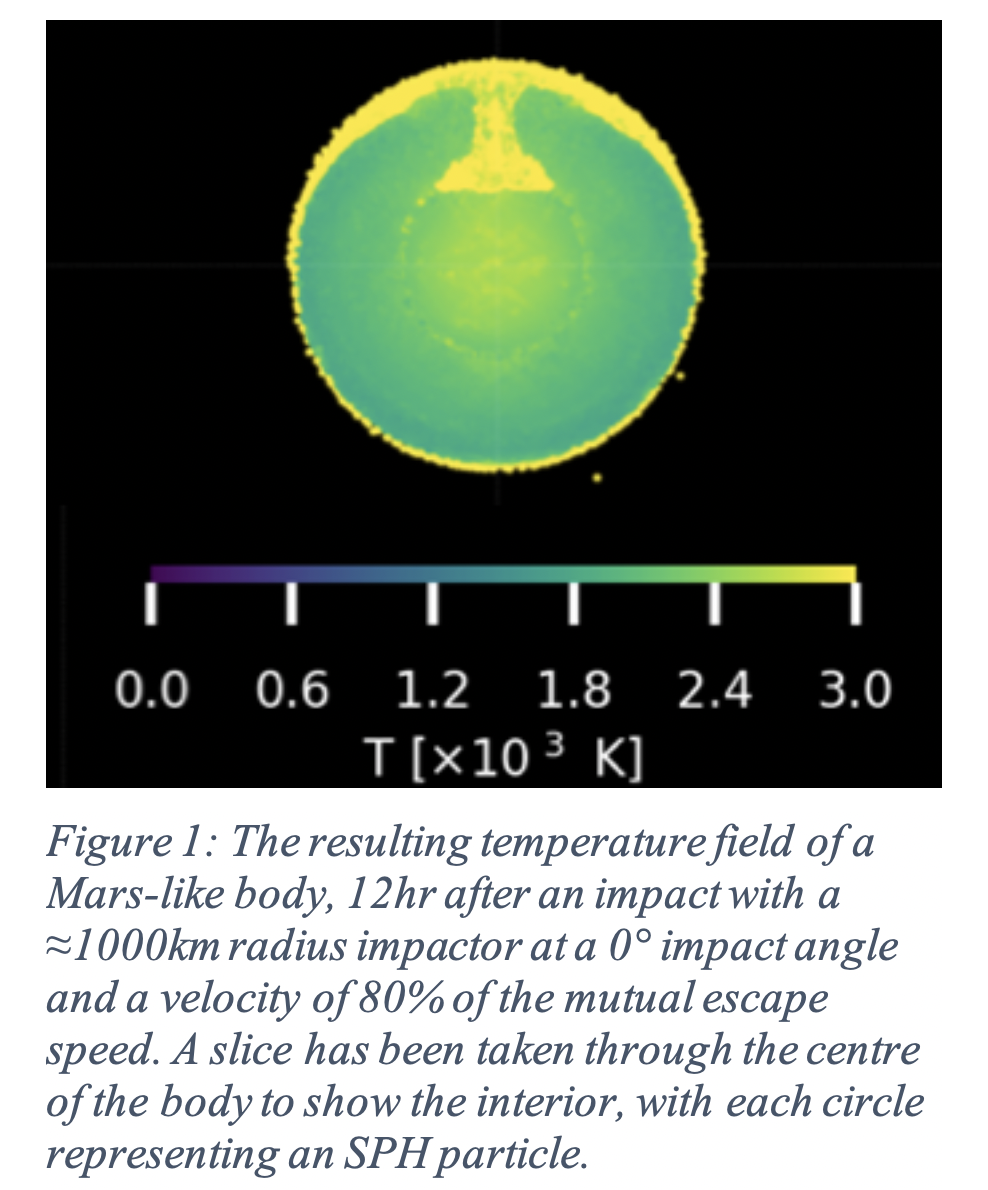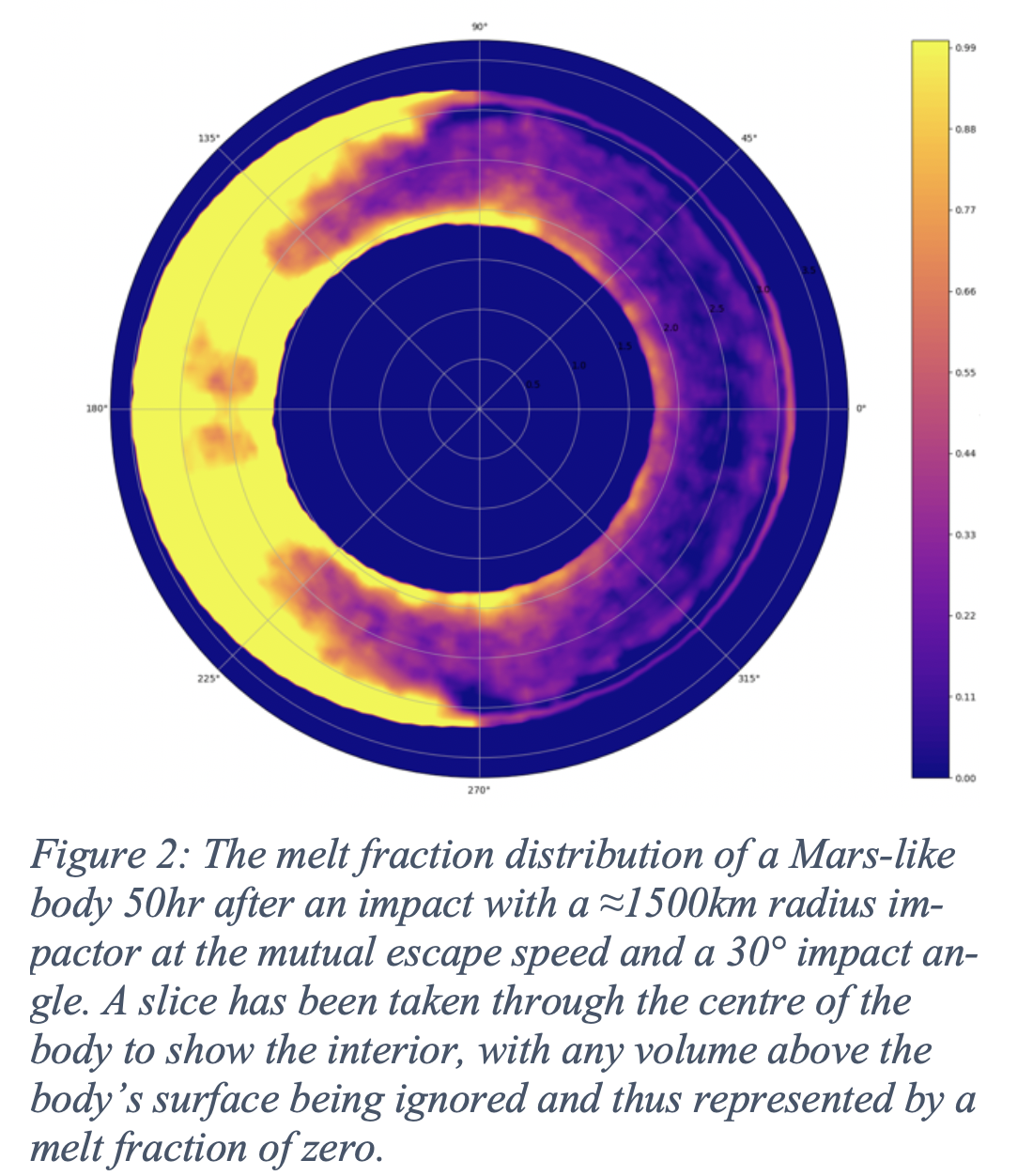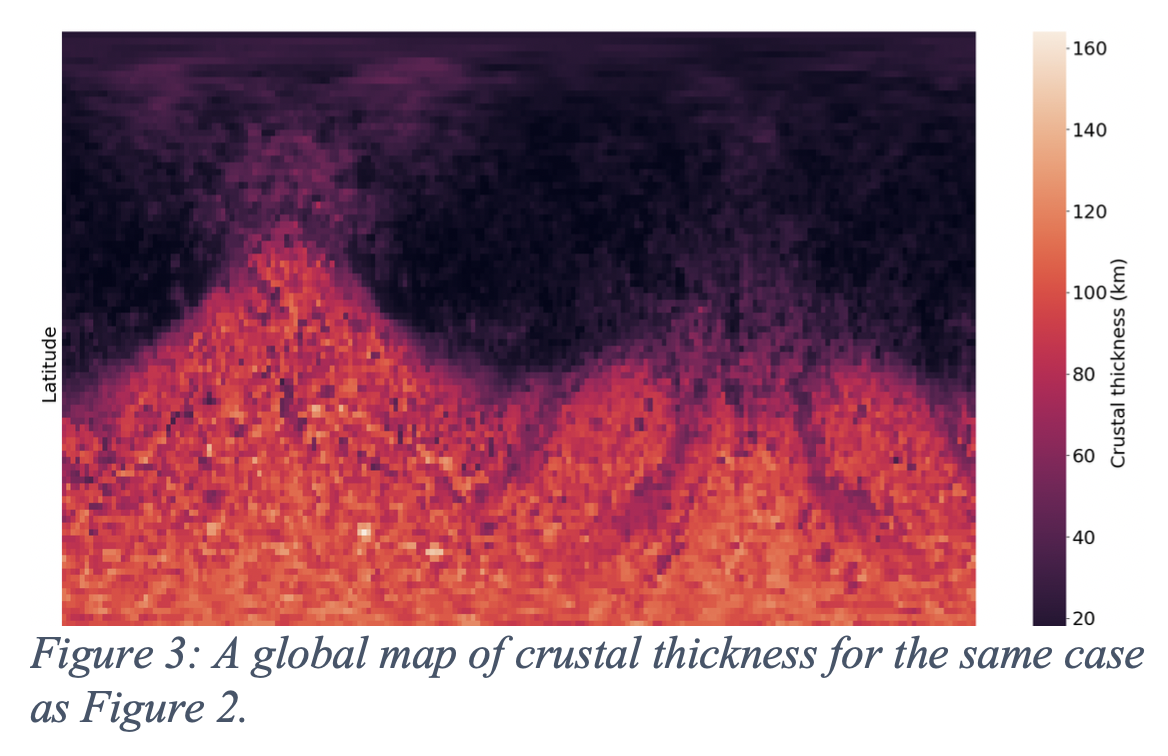Identifying the Sweet Spot for an Impact-Induced Martian Dichotomy
- 1Universität Bern, Physics, Space Research & Planetary Sciences (WP), Bern, Switzerland
- 2Bayerisches Geoinstitut, Universität Bayreuth, Bayreuth, Germany
Introduction
The martian crustal dichotomy predominantly refers to the 4-8 km difference in elevation between the southern hemisphere and an apparent basin covering roughly 42% of the north, with this topographical picture being strongly reflected in distribution of crust below. Other associated features include a higher density of volcanoes and visible impact craters in the south relative to the north.
Most studies attempting to explain these properties have supported one of two theories; either the dichotomy formed solely through geodynamic processes [1], or a giant impact occurred that imprinted the crustal cavity in the northern hemisphere that is observed today [2]. Recent work has proved the importance of coupling these hypotheses, introducing a hybrid exogenic-endogenic scenario whereby a giant impact triggered a localized magma ocean and subsequent superplume in the southern hemisphere [3]. This has, however, only been investigated using a very limited range of initial parameters, all of which lead to significant heating deep into the mantle. This therefore motivates an interesting area of study – is there a sweet spot in the parameter space where hemispherically-thickened crust is the most likely outcome?
We aim to answer this question using a suite of smoothed-particle hydrodynamics (SPH) simulations, using the SPHLATCH code [3,4], that explore a large parameter-space chosen with the intention of limited internal heating. For the analysis of the simulation outcomes we apply a newly developed scheme to estimate the thickness and distribution of (newly formed or re-distributed) post-impact crust.
Method
The chosen initial parameters for the main suite of SPH simulations are as follows: impact angles of 0-90° in steps of 15°; impact velocities of 1.0, 1.2 and 1.4 times the mutual escape speed; impactor radii of 1000km, 1500km and 2000km; and relative core masses of 25% and 50%. All of these simulations use a resolution of 200,000 SPH particles, with near head-on collisions (0-30°) being modelled for 50 hours after impact and oblique collisions (45-90°) for 200 hours to allow for any secondary (or even tertiary) impacts.
Each model includes the effects of shear strength and plasticity (via a Drucker-Prager-like yield criterion) as such effects have been shown to be significant on the scales concerned in this study [3,4]. Moreover, the sophisticated equation of state ANEOS is being used along with a Mars-specific solidus [6] to accurately calculate the physical environment in which such solid characteristics must be considered.
In all of these studies, both Mars and the impactor are treated as differentiated bodies composed of an iron core and a silicate mantle. An example result of one of these simulations can be seen in Figure 1.

Preliminary Results
The SPH kernel interpolation is used to convert the data of the simulations into high resolution, uniformly-spaced spherical grids. For each grid cell point we calculate a melt fraction using a simple linear relation involving the temperature, solidus temperature and liquidus temperature for the given pressure [7]. The Mars-specific solidus mentioned earlier is used for this purpose, along with a pressure-dependent peridotite liquidus [3,8] that has been modified to include the latent heat of melting. This then gives us a distribution of melt fraction throughout the entire mantle of our Mars-like body, as can be seen in Figure 2.

In order to estimate what fraction of this melt crystallises into basaltic to andesitic crust we use the pyroxene fraction of a fertile mantle: roughly 20% by mass [9]. In addition, any melt at pressures greater than approximately 7.4 GPa (equivalent to a neutral buoyancy depth of around 600km) [10] should become negatively buoyant and is therefore ignored in our crustal calculations. For each latitude and longitude coordinate on the grid, we can now find a total crustal mass and convert this to a thickness using a current estimate on the density of the martian crust [11]. This allows us to create maps of crustal thickness for each of our SPH simulations, an example of which can be seen in Figure 3.

The initial results of this study have revealed promising hemispherical features in certain cases, with further analysis being made in an attempt to compare the results to those of the observational data in a quantitative manner (e.g. through bimodal fitting of crustal thickness histograms and spherical harmonics power spectra). In addition, the effects of a uniform, primordial crust being present on Mars before the dichotomy-forming event are being studied, as well as an investigation into the final distribution of the impactor material as this could be chemically distinct from the primordial martian composition.
Of notable interest are the results of the grazing impact angles, as some of the initial kinetic energy of the impactor is converted into rotational energy of Mars, allowing for subsequent merging events of decreased impact velocity. In addition, the effects of material strength have been found to be non-negligible, in contrast to previous beliefs that such aspects can be ignored on the length-scales involved in planetary collisions.
Acknowledgements
This project is supported by the Swiss National Science Foundation under grant 200021_175630. We gratefully acknowledge the developers of the SPHLATCH code, including A. Reufer and A. Emsenhuber.
References
[1] Keller, T. and Tackley, P. J. (2009) Icarus, 202(2):429–443. [2] Marinova, M. M., Aharonson, O., and Asphaug, E. (2008) Nature, 453(7199):1216–1219. [3] Golabek, G. J., Emsenhuber, A., Jutzi, M., Asphaug, E. I., and Gerya, T. V. (2018) Icarus, 301:235–246. [4] Emsenhuber, A., Jutzi, M., and Benz, W. (2018) Icarus, 301:247–257. [5] Jutzi, M. and Asphaug, E. (2011) Nature, 476(7358):69-72. [6] Duncan, M. S., Schmerr, N. C., Bertka, C. M., and Fei, Y. (2018) Geophysical Research Letters, 45:10, 211–10,220. [7] Burg, J.-P., Gerya, T.V., (2005) J. Metamorp. Geol., 23:75–95. [8] Wade, J. , Wood, B.J. (2005) Sci. Lett., 236:78–95. [9] McKenzie, D., Bickle, M.J. (1988) J. Petrol., 29:625–679. [10] Breuer, D., Spohn, T. (2006) Planet. Space Sci., 54:153–169. [11] Goossens, S. et al. (2017) Geophys. Res. Lett., 44:7686–7694.
How to cite: Ballantyne, H., Jutzi, M., and Golabek, G. J.: Identifying the Sweet Spot for an Impact-Induced Martian Dichotomy, Europlanet Science Congress 2021, online, 13–24 Sep 2021, EPSC2021-765, https://doi.org/10.5194/epsc2021-765, 2021.